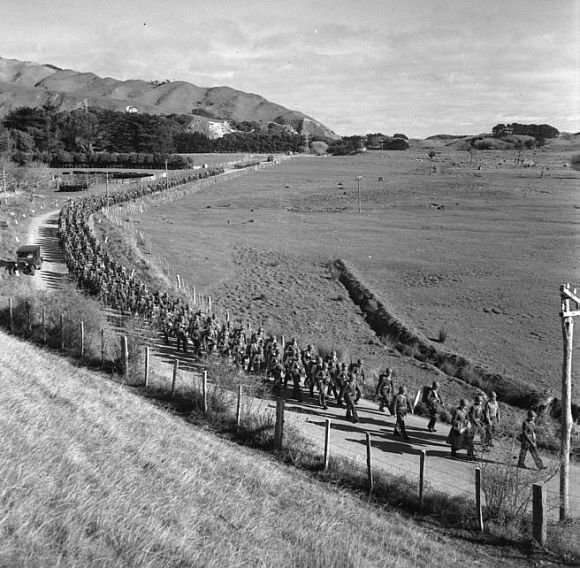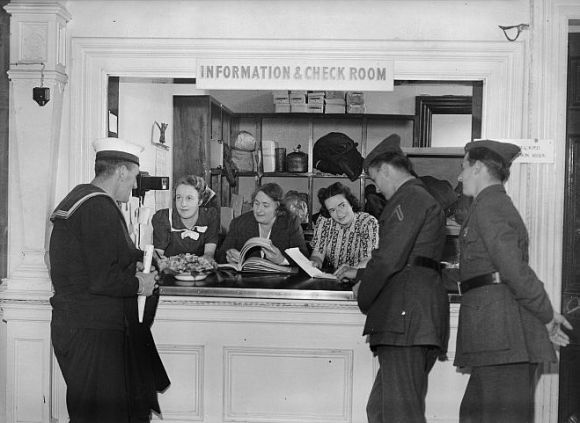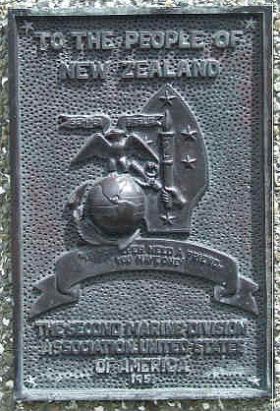Zeitblick
- Series A HillAc Production |
|
City,
My City - Series Two
Part 2
|
|
There is little doubt that, had the United States not come into the Second World War when it did, the outcome for all of us would have been very, very different. The shadow dragged over much of the world in 1939 would have become a permanent evil and we, as we presently know ourselves, would not exist. On a war footing the United States could apply its full industrial might to re-arming and retaliation. Geographically America was half way between European hostilities and those in the Western Pacific (and a long way from both) and she needed friendly bases in the Pacific for soldiers and the storage of imperative supplies. New Zealand was one of the obvious choices and in mid-1942 a friendly armada of American warships and transports arrived in Wellington Harbour. Tens of thousands of troops of the 2nd Marine Division, USMC, and tons of supplies, turned up on Wellington's doorstep, unannounced owing to the very stringent censorship of the day. Auckland, too, experienced the same invasion with Army and Marine servicemen arriving in vast numbers to occupy camps from Pukehoe in the south to Warkworth and Kaipara in the north. Flotillas of Liberty Ships - the standard American transport of 7,176 tons displacement - moored at Aotea Quay to discharged their cargo of war supplies. These supplies were for the troops encamped here and to stockpile for the day when the soldiers left for battlefields in the Pacific. Several camps and facilities, such as hospitals and warehouses, were built in Wellington and in the greater Wellington area, using both New Zealand and American labour. US camps and facilities in and around Wellington were located at Newtown, Brooklyn, Oriental Bay, Anderson Park and Kaiwharawhara in central Wellington and Johnsonville, Gracefield, Hutt Park, Waterloo, Silverstream, Trentham, Titahi Bay, Paekakariki, Paraparaumu Beach and Masterton in outlying districts.
American troops touched the lives of thousands of Wellingtonians and in their turn became very fond of the local Kiwis. Many American soldiers, new to the uniform because of the war, had not traveled far from their home towns or farms and, certainly not, overseas. Most were unsure of what to find at the end of their voyage. "...we honestly didn't know about New Zealand. We didn't know where we were when we pulled in wharf-side. But then we didn't know about Canada either." The soldiers were warmly welcomed into the lives and homes of Wellingtonians. Comments in the letters and memoirs of many a Marine reflected the friendship that grew between the local civilians and the soldiers; "...found the people really genuine and hospitable"; "New Zealand treated us so generously that I have never forgotten it"; "We all miss New Zealand and hope we come back there soon"; "We loved the people - hell it was the only thing that saved us". Young, well-dressed, well-paid, and very polite would describe many a Marine who walked Wellington's streets in 1942 and 1943. Having nothing else to spend their generous pay on, the soldiers quickly developed a reputation for big-heartedness, spendthrift and generosity. In those days 1 US dollar was exchanged for 6 NZ shillings. A veritable fortune when a meal of steak and eggs in a Wellington restaurant (a Marine favorite) was just 2 shillings and sixpence. This, coupled with an instantly recognisable accent, meant that the Marines had an immediate and exotic appeal toward the local population. Understandably this appeal extended to the local ladies and many a maid was smitten by the charms of a tall, handsome Marine. With most able-bodied Wellington men overseas, except those considered to be employed in "essential services", there was no shortage of young women. Many were to become war brides and go to America after the war. Alternatively, some Marines who married local girls, preferred to remain in Wellington.
Not everyone, of course, was happy with having many thousands of American troops camped in and around Wellington. Perception is everything, often becoming fact, and the perception of the Kiwi soldier was that these "Yanks" - ample pay packets, smooth nature, snappy uniforms and all - had moved into their space. Comments such as "We hated their guts, with the stories we got"; "We didn't get too uptight about the Americans and their fighting ability, but we sure were bitter about what was going on in New Zealand with our women"; "No, if there were bitter feelings about the Yanks it was only about one thing - women" clearly indicated the feelings that were expressed by New Zealand servicemen overseas. New Zealand soldiers who were rotated back from the war came into conflict with American soldiers and such conflicts were not uncommon. More usual, however, were the fights between Marines and US Army servicemen, the GIs who the Marines called "Doggies". American Military Police, the feared MPs with their long batons, were always on hand to sort out any skirmishes. One major conflict, which has gone down in Wellington folklore as "The Battle of Manners Street", took place on the evening of Saturday, April 3rd 1943. Stories abound as to the reasons behind the fracas, who was to blame, how it developed and how many were hurt and the subject is still frequently debated. Reports concerning the death of two Americans are of dubious origin. In my Mothers words there were "Some bloody noses and bruises".
During these years a strong and lasting bond was established between Wellington and the 2nd Division, USMC. This bond is reflected in a smaller plaque below the one at the beginning of this story and bears the words "To the People of New Zealand. If you ever need a friend, you have one. The Second Marine Division Association, United States. 1951." Emblazoned proudly across the centre is the Marine motto, Semper Fidelis (Always Faithful). Wellington remembers the sacrifices made by those young Americans, their willingness to fight on behalf of a city and country which many barely knew but which many came to know and love. This story commemorates the courage and heroism of those troops who snatched back the Pacific, island by blood-stained island. Many lost their lives in the slaughter and it is to them that we owe our safe and peaceful existence. God Bless them. The title for this story came from something my Mother said to me as she told me of her memories of the US Marines in and around Wellington. Thanks Mum. © Peter Wells, Wellington, New Zealand |



